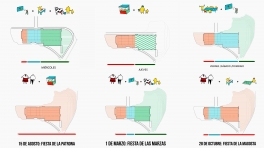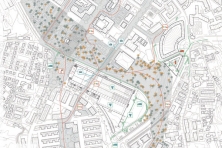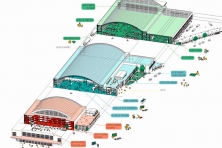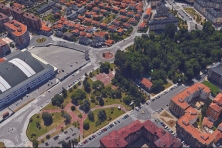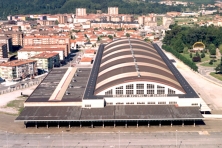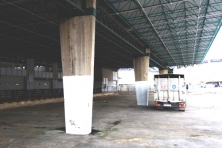De la manzana al mercado
Torrelavega (ES) - Special Mention
TEAM DATA
Team Representative: Rapahaël Hoyet (FR) – urbanist Associates: Lara Bretones Torrecilla (ES) – urbanist architect; Alba Navarrete (ES), María García (ES) – architects
Made in - 80 du faubourg Saint-Denis, 75010 Paris (FR)
+33 144 836 699 - contact@made-in.work - made-in.work
Improvistos - Navarra 24bis 2°A, 28039 Madrid (ES)
+34 914 597 592 - infor@improvistos.org - improvistos.org
See the complete listing of portraits here
See the site page here

L. Bretones Torrecilla, R. Hoyet, A. Navarrete & M. García
INTERVIEW
Click on the images to enlarge
1. How did you form the team for the competition?
Our team results from the association of two urban design agencies that share the same vision of the city but using different means in their practice. Improvistos (Alba Navarrete and María García – Madrid based) have a creative approach with a great place given to drawings. It is a tool from expression to reflexion: concepts are drawn in situ, inhabitants’ paths become lively and discussion starts. Made in (Lara Bretones and Raphaël Hoyet – Paris based) tries and implicates stakeholders in their urban design process, beginning with models. Despite our different careers, we believe in the strength of urban scale in the project. This Europan session was the great opportunity to share both our practice and culture in a team work. Besides, Torrelavega site was already known by two members of the team: Alba from Improvistos and Lara from made in.
2. How do you define the main issue of your project, and how did you answer on this session main topic: the place of productive activities within the city?
Torrelavega follows the path of the cities very well integrated in the industrial development of the twentieth century. After a flourishing period, the city now faces loss of inhabitants, the rise of the unemployment rate and the spread of vacant spaces. This last spatial consequence can be treated by architecture because those voids materialize economic, social, environmental lacks. We built our project from this point of view, trying to reshape the production and economical fabric through the whole city, based on existing activities. This new urban pattern mixes production and leisure, culture and agriculture. Diversity is coming from interaction between urban fabric and new activities. We deploy the strategy all over the town in order to create a network linking different parts, especially the unseen parts.
3. How did this issue and the questions raised by the site mutation meet?
Working through various scales, our proposal had to get out the Livestock Market. It has been set at the core of the strategy and its reorganization results from the spatial project at urban scale. Our aim is to put the formation in between the duo producers / buyers as a tool for the renewal of the productive city. We also need iconic and unifying places. Thus, urban strategy and evolution of the building are led together, each one filling the other.
4. Have you treated this issue previously? What were the reference projects that inspired yours?
We are very concerned by the return of an economical fabric inside the urban fabric and not only shops. Tactical urbanism and temporary occupation, like “les Grands Voisins”, proved that special places can hold new activities. But we also have to consider the long-term strategy with smaller places, throughout a town. This is why we focus on the evolution of the ground floor in our work. It is an essential tool for diversity as long as we are able to consider it differently.
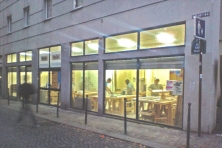
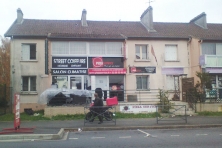
5. Urban-architectural projects like the ones in Europan can only be implemented together with the actors through a negotiated process and in time. How did you consider this issue in your project?
In our proposal, there is a paragraph related to a participatory process in which spatial and programmatic issues can be discussed with all the agents implied. For us, considering the iconic place of the Livestock Market and our ambition at city scale, every inhabitant, every initiative has to feel concern by the evolution of the Market. In our professional practice, we develop tools and means for this cooperation which has to turn into co-design.
6. Is it the first time you have been awarded a prize at Europan? How could this help you in your professional career?
We have not been awarded before even if Raphaël Hoyet contributed with an awarded team from previous session, Projet Base Vie in Goussainville (FR). For us, it is a good opportunity to put a light over our approach and methods, in a larger circle than we are used to. In addition, we are looking forward to meeting the Torrelavega community to explain our process.
